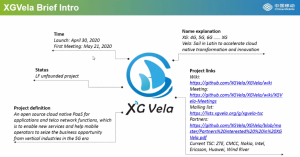Track: Shift to Release Train Presenters/Moderators: Catherine Lefevre | ›The Challenges from LFN Projects ›Release Cadence in Other Open Source projects >Shift to Release Train & Brainstorming 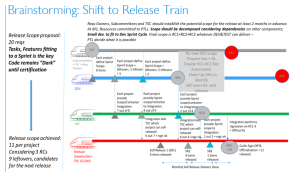
Wiki notes: Shift to Release Train 2020-06-23 | ›How can we release more frequently, smaller scope without impacting the SW quality? ›How can we change the waterfall-ish development model? ›How can we get enough details about candidates requirements prior the release? ›How to manage the release in case of people turn-over? ›How to handle the scope and maintain a balance between Usecase/Functional reqs (attractive) and Non functional reqs (less sexy)? | |
Track: XGVela Presenters/Moderators: Qihui Zhao | |
| - Alignment with CNTT/CNCF TUG and O-RAN/ONAP in order to define their role as part of XGVela and identify what can be leveraged from the existing projects
- Introduction of XGVela to the TAC team
|
Track: Cloud Native in Telecom Cloud Presenters/Moderators: Qihui Zhao, Ying Li | 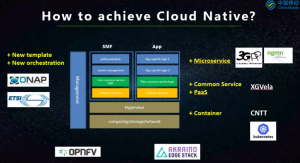 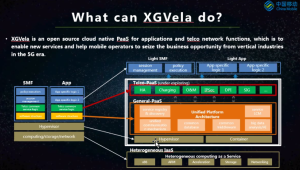
- Plan to align with CNTT RA-2 (Kubernetes)
|
| - Alignment with CNTT/CNCF TUG and O-RAN/ONAP in order to define their role as part of XGVela and identify what can be leveraged from the existing projects
- Introduction of XGVela to the TAC team
|
| ONAP Track | Key Points | Challenges | Next Steps/Action Items |
Best practices for updating software components Presenters: Pawel Pawlak Amy Zwarico | Reviewed mandatory upgrades to Java 11 and Python 3 for all projects Migration of ONAP to standard infrastructure versions: Docker, Kubernetes, OS images, databases, etc (see Database, Java, Python, Docker, Kubernetes, and Image Versions) Updating vulnerable direct dependencies: - SECCOM repo specific recommendations on the Security Vulnerabilities protected wiki space
- Must be complete by M2
| Resources to do the non-functional work Potential dependencies that conflict with new versions | SECCOM will have representative at the weekly PTL call to answer questions PTLS and others are always welcome to attend the SECCOM weekly on Tuesdays to raise issues PTLs secure resources and plan to identify show stoppers as soon as possible (M1) |
EUAG Operator Survey & In-Depth Analysis On Consumption Model
Presenters: Atul Purohit | Presented End User Advisory Group's survey on various ONAP consumption models, which led to creation of EUAG white paper Key topics covered - › Introduction – EUAG › What Survey & Why › Survey Questions, Deductions › Recommendations › Paper & Wrap - Up | View file |
|---|
| name | EUAG White Paper Presentation.pptx |
|---|
| height | 250 |
|---|
|
| None | - EUAG should create an action plan out of survey inference, what it means for various committees and how can the feedback be provided back to CSPs
- Survey sample was about 50% of overall members and 75% of active members, to make similar activities more impactful in future perhaps the survey can be done with larger sample size
|
OOM Status update: what's planned internally Presenters/Moderators: Sylvain Desbureaux, Krzysztof Opasiak | Review of the planned OOM changes : Support of Helm V3 Kubernetes V1.17 (or 1.18) Migrate to Seccom recommended Versions Update defaults (use Ingress, Storage Class, Hardened OS) | Might be breaking gating during changes, impact deployments | check if Helm V3 requires Kubernetes v1.17+ |
OOM Status update: consequences on other components Presenters/Moderators: Sylvain Desbureaux, Krzysztof Opasiak | Review of the required changes on components helm charts VS requirements presentation of changes, use of templates, adding appender to Logback to support STDOUT as additional output Container that do not contain ONAP code should not be hosted on Nexus No Root access to DB Application config should be fully prepared before starting the container Containers must crash properly when a failure occurs No more Nodeports AAF optional (component should work without AAF even in degraded mode) HTTPS is mandatory but should be configurable (disable in case of Service Mesh as this will be offloaded to Service Mesh) Container RootFS should be mounted as ReadOnly Commit message rules for OOM | AAF removal or optional / POC SMesh | SecCom to follow up and define what disabling AAF means |
Requirements Traceability: Initial Request through TSC Approval Presenters/Moderators: Alla Goldner, Chaker Al-Hakim, Pawel Pawlak, Pamela Dragosh, David McBride, Catherine Lefevre | - brainstorming and discussion on aligning the ONAP requirements pipeline
- Consensus:
- any requirements- regardless of source- should go through the requirements subcommittee.
- and euag submits requirements to req. sub where they are vetted
- committee consolidates backlog
- committee should make prioritization recommendations to the TSC
wiki: 2020 June vDTF ONAP Requirements Traceability: Initial Request through TSC Approval | - How can we streamline the requirements coming from different sources inside and outside from the ONAP Community?
- As an example, EUAG → REq Subcommittee prioritirised → (Architecture Review) → TSC
| - Enhance the mission of the Requirements Subcommittee:
- Act as the ONAP Product Owners
- Recommend Prioritization to the TSC
- Create the consolidated ONAP Backlog
|
| The presentation covers Frankfurt CNF instantiation improvements on vFW use case example - Changed modelling of the vFW CNF - split into 4 helm packages to benefit from CDS resource assignment
- Change from a'la Carte VNF-API instantiation flow into Macro GR-API with CDS
- Utilization of CDS for automatic assignment of Helm package overrides
- CDS uploads optionally profile which allows for further helm enrichment like extra k8s resources
Use Case Doc: https://onap-doc.readthedocs.io/projects/onap-integration/en/latest/docs_vFW_CNF_CDS.html#docs-vfw-cnf-cds Notes: 2020 June vDTF ONAP vFW CNF use case evolution | - We lack of the use case automation scripts, however, there is very good documentation + postman collection
- We leverage VNF flow in SO and still, we need to use dummy heat templates in the onboarding package
- vFW use case requires dedicated k8s cluster with virtlet, ovn4k8s and multus
- Data in AAI is still not synchronized with k8s
- Status of instantiated resources is not monitored by SO and
| - vFW CNF Use case automation with robot scripts and use of modern VID UI
- Support of Close Loop
- https://jira.onap.org/browse/REQ-341 - CNF SO orchestration Enhancements
- Potentially new use case: VNF + CNF Heterogeneous service and/or pure CNF (without a need of specific k8s cluster setup)
|
Orchestration of 5G CNFs using Multicloud K8s plugin Presenter: Sandeep Sharma | - Walkthrough of how ONAP was used to instantiate a 5G Core CNF.
- More details & a demo are available in the Webinar that this team did
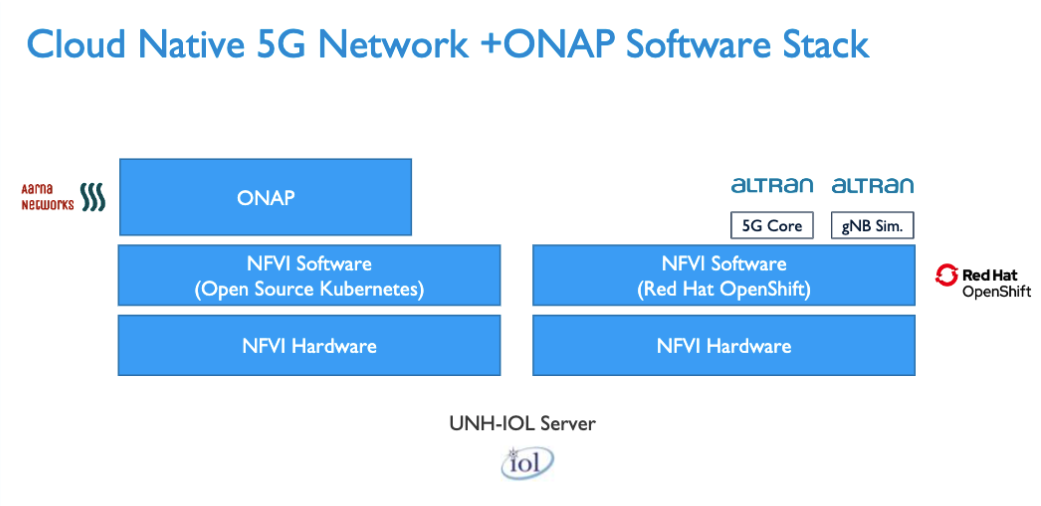
| - Did use SDC and MultiCloud K8S plugin, but did not use SO. Did have one manual step.
- Container image was in a local K8S repository, not bundled in the service package
|
|
Python ONAP SDK Presenter: Michal Jagiello | Version 1.0 of the SDK was released and will be available using pip. Presentation provided an overview of the project capabilities: - Communication and handling with ONAP services using HTTP/S APIs
- High level of abstraction
- Easy to use, even if you don't know what is possible "underneath"
SDK requires Python 3.7 or higher and was tested with ONAP Frankfurt. | View file |
|---|
| name | lfn_onapsdk.pdf |
|---|
| height | 150 |
|---|
|
|
| - Add handling for the macro flow
- migrate onap_tests repository to pythonsdk_tests
- Add close loop examples coming in next versions
|
Frankfurt Post Mortem Presenter : David McBride | Review Frankfurt Schedule changes & pain points - number of shifts in schedule (not so much the total delay) raised concerns
- scope size (do we take in too much?)
- very late avail of final dockers
- use case not clear if they are leveraging or need more ONAP dev - cannot know until actually running it
- self release is painful, takes time for multi sub projects
- Lots of remaining open bugs at M4
- Observations on certificates, exceptions to milestones

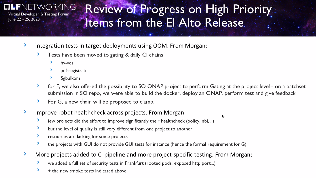
| Release more frequently VS time
| - Move to a more continous approach
- Release at each milestone ? with working small steps
- At RC0 provide %age completed, which ones are not done yet?
|
| Presentations given on the 5G & PNF Use Cases https://wiki.onap.org/display/DW/Guilin+%28R7%29+-+Use+Cases (Presentation Slides are there also) There are many dedicated 5G/PNF Use Case deep dives in the DDF The U/C Realization call will engage PTLs: https://wiki.onap.org/display/DW/R7+Use+Case+Realization+Meetings+MoM Overview of the Use Case Process Page (Way of Working WoW) https://wiki.onap.org/pages/viewpage.action?pageId=79204390 Andy Mayer gave an overview of the Generic Information Template: https://wiki.onap.org/display/DW/Generic+Information+Element+Template |
|
|
Overview of k8splugin v2 Ritu Sood Eric Multanen | |
| The code (as demonstrated) along with test scripts and swagger documents will be added to the multicloud/k8s repository soon. https://github.com/onap/multicloud-k8s |
| CNTT Track | Key Points | Challenges | Next Steps/Action Items |
| Performance (Joint with OPNFV) | - Great Discussion around performance and it's relation to CNTT.
- Discussion to be continued with Al Morton , Trevor Cooper, and Mark Beierl during CVC using Al proposed 4-tier structure (described below):
- Functional tests lead to Performance tests of the functions. A subset of the most important performance tests are elevated to Benchmark status (with more precise specifications of methods, etc.). Acceptance thresholds could be established for "Performance Conformance", if agreed.
|
| - Continue discussion in CVC.
- Map 4-tier structure to CNTT.
|
| Traceability Test Cases (Joint with OPNFV) | - Great progress demonstrated by Cedric Ollivierto cover RA-1/RC-1 Requirements
|
|
|
| Use cases of SDN solution | - Interesting and detailed presentation by Ying Li and Shasha Guo of SDN implementations for several use cases like Traffic Mirroring and Routing Configuration, showing code snipets, network diagrams and parameter mappings
|
|
|
| Field Trial Status (Joint with OPNFV) | - Presentation by Cedric Ollivier - update on the CNTT Field Trial. CNTT RC changelog from Baldy presented (9 out of 2000 single tests removed) - good outcome. Orange IAAS: 10 remaining single test failures, targeting mid-July to complete. RC is ready to use by vendors and operators.
|
|
|
| Next CNTT OpenStack Release & Cyborg Acceleration Mgmt | - Presentation on CNTT OpenStack Release selection by Pankaj Goyal et al, and second half by Shasha Guo on Cyborg Acceleration Mgmt.
- OSTK Pike was selected in Paris, but the next version was selected by a formal process and against defined criteria, the process started at Baldy vF2F in April 2020. Train met the selection criteria and is recommended as the next CNTT OSTK version. Recommendation: utilize Ussuri OSTK release for Cyborg API v2.0 service (as it is incompatible with Train). Upstream: Cyborg should fix their API in Train release as per OpenStack policy.
- Discussion whether CNTT should jump straight to Ussuri to avoid back porting problems for Cyborg. An option for consideration for TSC (the only criterion not met by Ussuri is 6+ month requirement)
- Shasha Guo and Ying Li on Cyborg acceleration: presented scenarios why we need to use Cyborg, and Cyborg enhancement requirements for CNTT.
|
| As a result of the discussion, the next step will be to present an option of moving straight to Ussuri. Action on Pankaj Goyal |
| OPNFV Track | Key Points | Challenges | Next Steps/Action Items |
| <Many CNTT meetings were Joint with OPNFV Today!> | See above - Scheduling was a non-challenge again today! |
|
|
| OPNFV TSC Meeting | Agenda - 2020-2021 Community Elections proceeding, TSC members are elected, Leadership position elections are the next steps.
- New Project Review on RI-2 in OPNFV, Wiki vote will proceed this week.
- TSC Roles and Responsibilities reviewed with the Community.
- OPNFV Internal Project Periodic Reviews continue (Project life-cycle assessment is also an outcome of TSC oversight)
- Key meetings/sessions on OPNFV Release Process and CIRV Software Demo later this week (Wednesday)
- Next Week: Review of feedback from the June Governing Board meeting.
Let's play Twister! 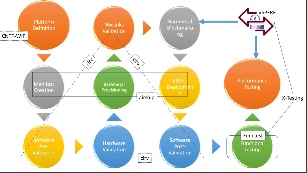
|
| Need to clarify OPNFV interactions with CVC/OVP: this entity was not formed yet at the time OPNFV was Chartered. |
OpenDaylight Track | | Challenges | Next Steps/Action Items |
|---|
ODL Micro Status & Next Steps | |
| - Tejas Nevrekarto share performance reports once available. Further elaboration in TWS once code is uploaded
|
ODL Platform API Changes and impact to downstream consumers |
|
|
|

